Image-Based Evaluation of Irradiation Effects in Brain Tissues by Measuring Absolute Electrical Conductivity Using MRI
Abstract
Simple Summary
Abstract
1. Introduction
2. Materials and Methods
2.1. Phantom Preparation for Validation
2.2. Animal Preparation
2.3. Radiation Exposure
2.4. Imaging Experiments
2.5. Conductivity Measurement and Analysis
3. Results
3.1. Phantom Imaging with Two Different Solutions
3.2. In Vivo Mouse Brain Imaging with Different Doses and Elapsed Times
4. Discussion
5. Conclusions
Author Contributions
Funding
Institutional Review Board Statement
Informed Consent Statement
Data Availability Statement
Conflicts of Interest
References
- Voges, J.; Treuer, H.; Sturm, V.; Büchner, C.; Lehrke, R.; Kocher, M.; Staar, S.; Kuchta, J.; Müller, R.P. Risk analysis of linear accelerator radiosurgery. Int. J. Radiat. Oncol. Biol. Phys. 1996, 36, 1055–1063. [Google Scholar] [CrossRef]
- Baskar, R.; Dai, J.; Wenlong, N.; Yeo, R.; Yeoh, K.W. Biological response of cancer cells to radiation treatment. Front. Mol. Biosci. 2014, 1, 24. [Google Scholar] [CrossRef]
- Smart, D. Radiation toxicity in the central nervous system: Mechanisms and strategies for injury reduction. Semin. Radiat. Oncol. 2017, 27, 332–339. [Google Scholar] [CrossRef]
- Brenner, D.J.; Doll, R.; Goodhead, D.T.; Hall, E.J.; Land, C.E.; Little, J.B.; Lubin, J.H.; Preston, D.L.; Puskin, J.S.; Ron, E.; et al. Cancer risks attributable to low doses of ionizing radiation: Assessing what we really know. Proc. Natl. Acad. Sci. USA 2003, 100, 13761–13766. [Google Scholar] [CrossRef]
- Cuccurullo, V.; Stasio, G.D.D.; Cascini, G.L.; Gatta, G.; Bianco, C. The molecular effects of ionizing radiations on brain cells: Radiation necrosis vs. tumor recurrence. Diagnostics 2019, 9, 127. [Google Scholar] [CrossRef]
- Clement, C.H. ICRP Statement on tissue reactions and early and late effects of radiation in normal tissues and organs-Threshold doses for tissue reactions in a radiation protection context, ICRP Publication 118. Ann. ICRP 2012, 41, 19–40. [Google Scholar]
- Dropcho, E.J. Central nervous system injury by therapeutic irradiation. Neurol. Clin. 1991, 9, 969–988. [Google Scholar] [CrossRef]
- Trivedi, R.; Khan, A.R.; Rana, P.; Haridas, S.; Kumar, B.S.H.; Manda, K.; Rathore, R.K.S.; Tripathi, R.P.; Khushu, S. Radiation-induced early changes in the brain and behavior: Serial diffusion tensor imaging and behavioral evaluation after graded doses of radiation. J. Neurosci. Res. 2012, 90, 2009–2019. [Google Scholar] [CrossRef] [PubMed]
- Pearce, M.S.; Salotti, J.A.; Little, M.P.; McHugh, K.; Lee, C.; Kim, K.P.; Howe, N.L.; Ronckers, C.M.; Rajaraman, P.; Sir Craft, A.W.; et al. Radiation exposure from CT scans in childhood and subsequent risk of leukaemia and brain tumours: A retrospective cohort study. Lancet 2012, 380, 499–505. [Google Scholar] [CrossRef]
- Siegel, J.A.; Pennington, C.W.; Sacks, B. Subjecting radiologic imaging to the linear no-threshold hypothesis: A non sequitur of non-trivial proportion. J. Nucl. Med. 2017, 58, 1–6. [Google Scholar] [CrossRef]
- Raber, J.; Rola, R.; LeFevour, A.; Morhardt, D.; Curley, J.; Mizumatsu, S.; VandenBerg, S.R.; Fike, J.R. Radiation-induced cognitive impairments are associated with changes in indicators of hippocampal neurogenesis. Radiat. Res. 2004, 162, 39–47. [Google Scholar] [CrossRef] [PubMed]
- Atwood, T.; Payne, V.S.; Zhao, W.; Brown, W.R.; Wheeler, K.T.; Zhu, J.M.; Robbins, M.E. Quantitative magnetic resonance spectroscopy reveals a potential relationship between radiation-induced changes in rat brain metabolites and cognitive impairment. Radiat. Res. 2007, 168, 574–581. [Google Scholar] [CrossRef]
- Greene-Schloesser, D.; Robbins, M.E.; Peiffer, A.M.; Shaw, E.G.; Wheeler, K.T.; Chan, M.D. Radiation-induced brain injury: A review. Front. Oncol. 2012, 2, 73. [Google Scholar] [CrossRef]
- Buckley, A.M.; Lynam-Lennon, N.; O’Neill, H.; O’Sullivan, J. Targeting hallmarks of cancer to enhance radiosensitivity in gastrointestinal cancers. Nat. Rev. Gastroenterol. Hepatol. 2020, 17, 298–313. [Google Scholar] [CrossRef]
- Yamada, M.K. A link between vascular damage and cognitive deficits after whole-brain radiation therapy for cancer: A clue to other types of dementia? Drug Discov. Ther. 2016, 10, 79–81. [Google Scholar] [CrossRef] [PubMed]
- Walker, A.J.; Ruzevick, J.; Malayeri, A.A.; Rigamonti, D.; Lim, M.; Redmond, K.J.; Kleinberg, L. Postradiation imaging changes in the CNS: How can we differentiate between treatment effect and disease progression? Future Oncol. 2014, 10, 1277–1297. [Google Scholar] [CrossRef]
- Jeraj, R.; Cao, Y.; Haken, R.K.T.; Hahn, C.; Marks, L. Imaging for assessment of radiation-induced normal tissue effects. Int. J. Radiat. Oncol. Biol. Phys. 2010, 76, S140–S144. [Google Scholar] [CrossRef] [PubMed]
- Park, J.A.; Kang, K.J.; Ko, I.O.; Lee, K.C.; Choi, B.K.; Katoch, N.; Kim, J.W.; Kim, H.J.; Kwon, O.I.; Woo, E.J. In vivo measurement of brain tissue response after irradiation: Comparison of T2 relaxation, apparent diffusion coefficient, and electrical conductivity. IEEE Trans. Med. Imaging 2019, 38, 2779–2784. [Google Scholar] [CrossRef] [PubMed]
- Seo, J.K.; Woo, E.J. Electrical tissue property imaging at low frequency using MREIT. IEEE Trans. Biomed. Eng. 2014, 61, 1390–1399. [Google Scholar]
- Jeong, W.C.; Sajib, S.Z.K.; Katoch, N.; Kim, H.J.; Kwon, O.I.; Woo, E.J. Anisotropic conductivity tensor imaging of in vivo canine brain using DT-MREIT. IEEE Trans. Med. Imaging 2017, 36, 124–131. [Google Scholar] [CrossRef]
- Katoch, N.; Choi, B.K.; Sajib, S.Z.K.; Lee, E.A.; Kim, H.J.; Kwon, O.I.; Woo, E.J. Conductivity tensor imaging of in vivo human brain and experimental validation using giant vesicle suspension. IEEE Trans. Med. Imaging 2019, 38, 1569–1577. [Google Scholar] [CrossRef]
- Yang, M.; Kim, H.; Kim, J.; Kim, S.H.; Kim, J.C.; Bae, C.S.; Kim, J.S.; Shin, T.; Moon, C. Fast neutron irradiation deteriorates hippocampus-related memory ability in adult mice. J. Vet. Sci. 2012, 13, 1–6. [Google Scholar] [CrossRef] [PubMed][Green Version]
- Seo, Y.S.; Ko, I.O.; Park, H.; Jeong, Y.J.; Park, J.A.; Kim, K.S.; Park, M.J.; Lee, H.J. Radiation-induced changes in tumor vessels and microenvironment contribute to therapeutic resistance in glioblastoma. Front. Oncol. 2019, 9, 1259. [Google Scholar] [CrossRef]
- Lesbats, C.; Katoch, N.; Minhas, A.S.; Taylor, A.; Kim, H.J.; Woo, E.J.; Poptani, H. High-frequency electrical properties tomography at 9.4T as a novel contrast mechanism for brain tumors. Magn. Reson. Med. 2021, 86, 382–392. [Google Scholar] [CrossRef] [PubMed]
- Syakrani, N.; Mengko, T.L.R.; Suksmono, A.B.; Baskoro, E.T. Comparison of PUMA and CUNWRAP to 2-D phase unwrapping. In Proceedings of the 2011 International Conference on Electrical Engineering and Informatics, Bandung, Indonesia, 17–19 July 2011; pp. 1–6. [Google Scholar]
- Gabriel, S.; Lau, R.W.; Gabriel, C. The dielectric properties of biological tissues: II. Measurements in the frequency range 10 Hz to 20 GHz. Phys. Med. Biol. 1996, 44, 2251–2269. [Google Scholar] [CrossRef]
- Kim, D.H.; Chauhan, M.; Kim, M.O.; Jeong, W.C.; Kim, H.J.; Sersa, I.; Kwon, O.I.; Woo, E.J. Frequency-dependent conductivity contrast for tissue characterization using a dual-frequency range conductivity mapping magnetic resonance method. IEEE Trans. Med. Imaging 2015, 34, 507–513. [Google Scholar] [CrossRef] [PubMed]
- Goodhead, D.T. Energy deposition stochastics and track structure: What about the target? Radiat. Prot. Dosim. 2006, 122, 3–15. [Google Scholar] [CrossRef]
- Anderson, R.M.; Marsden, S.J.; Wright, E.G.; Kadhim, M.A.; Goodhead, D.T.; Griffin, C.S. Complex chromosome aberrations in peripheral blood lymphocytes as a potential biomarker of exposure to high-LET alpha-particles. Int. J. Radiat. Biol. 2000, 76, 31–42. [Google Scholar] [PubMed]
- Brenner, D.J.; Ward, W.F. Constraints on energy deposition and target size of multiply damaged sites associated with DNA double-strand breaks. Int. J. Radiat. Biol. 1992, 61, 737–748. [Google Scholar] [CrossRef]
- Kim, E.H.; Kim, M.S.; Lee, K.H.; Sai, S.; Jeong, Y.K.; Koh, J.S.; Kong, C.B. Effect of low- and high-linear energy transfer radiation on in vitro and orthotopic in vivo models of osteosarcoma by activation of caspase-3 and -9. Int. J. Oncol. 2017, 51, 1124–1134. [Google Scholar] [CrossRef]
- Garnett, C.T.; Palena, C.; Chakraborty, M.; Tsang, K.Y.; Schlom, J.; Hodge, J.W. Sublethal irradiation of human tumor cells modulates phenotype resulting in enhanced killing by cytotoxic T lymphocytes. Cancer Res. 2004, 64, 7985–7994. [Google Scholar] [CrossRef] [PubMed]
- Haddy, N.; Mousannif, A.; Tukenova, M.; Guibout, C.; Grill, J.; Dhermain, F.; Pacquement, H.; Oberlin, O.; El-Fayech, C.; Rubino, C.; et al. Relationship between the brain radiation dose for the treatment of childhood cancer and the risk of long-term cerebrovascular mortality. Brain 2011, 134, 1362–1372. [Google Scholar] [CrossRef] [PubMed]
- Hubenak, J.R.; Zhang, Q.; Branch, C.D.; Kronowitz, S.J. Mechanisms of injury to normal tissue after radiotherapy: A review. Plast. Reconstr. Surg. 2014, 133, 49e–56e. [Google Scholar] [CrossRef] [PubMed]
- Connor, M.; Karunamuni, R.; McDonald, C.; White, N.; Pettersson, N.; Moiseenko, V.; Seibert, T.; Marshall, D.; Cervino, L.; Bartsch, H.; et al. Dose-dependent white matter damage after brain radiotherapy. Radiother. Oncol. 2016, 121, 209–216. [Google Scholar] [CrossRef] [PubMed]
- Valk, P.E.; Dillon, W.P. Radiation injury of the brain. Am. J. Neuroradiol. 1991, 12, 45–62. [Google Scholar] [PubMed]
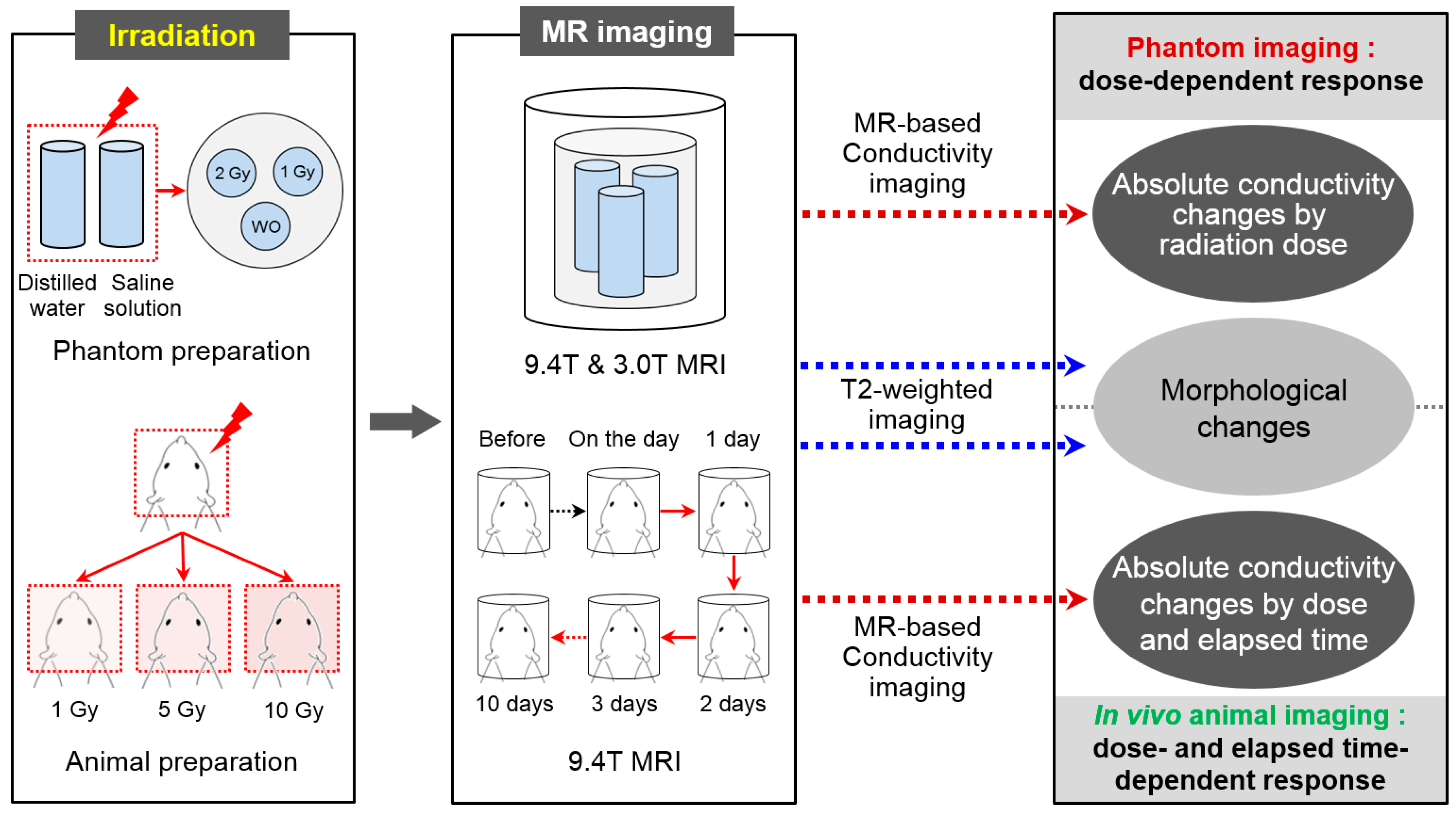
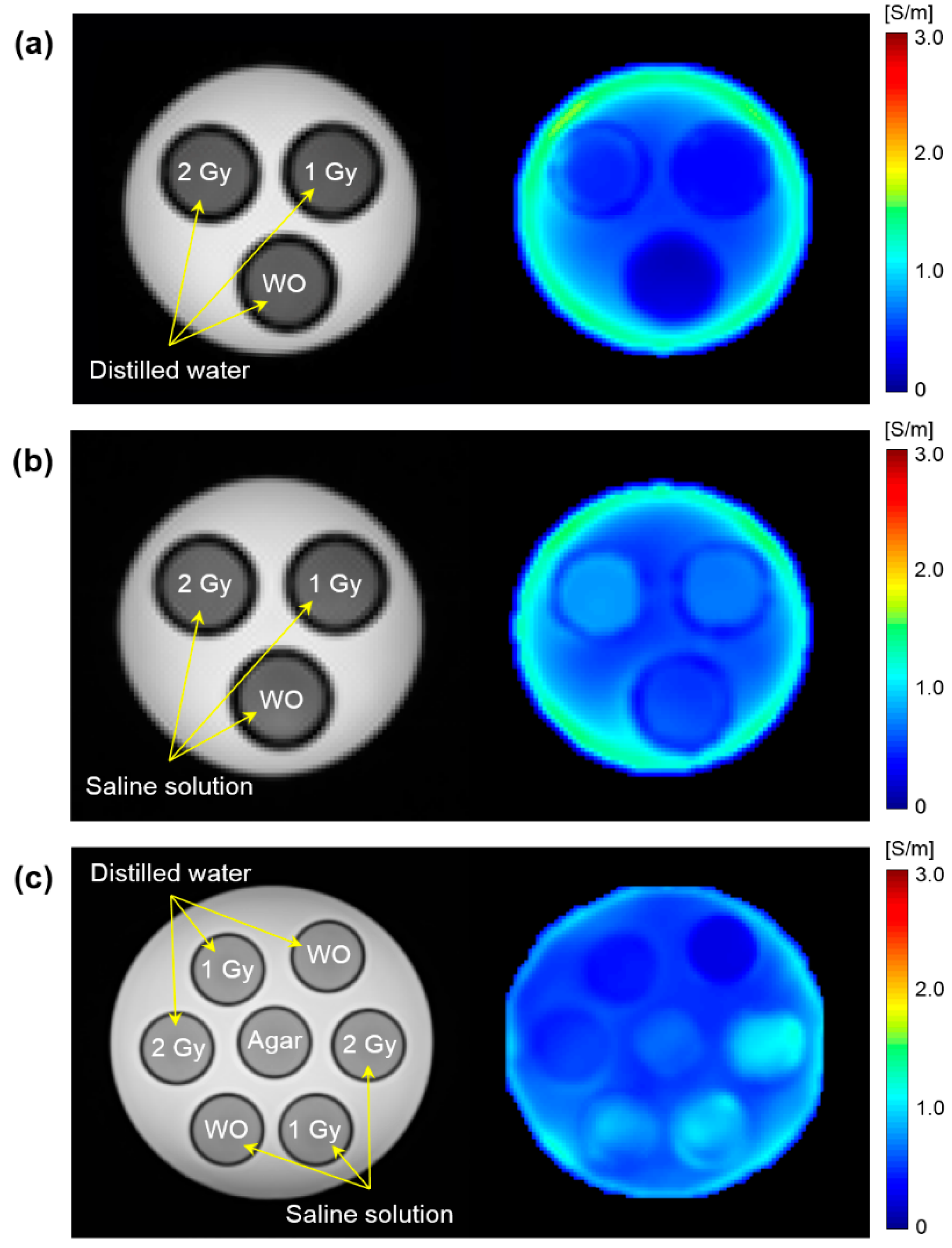
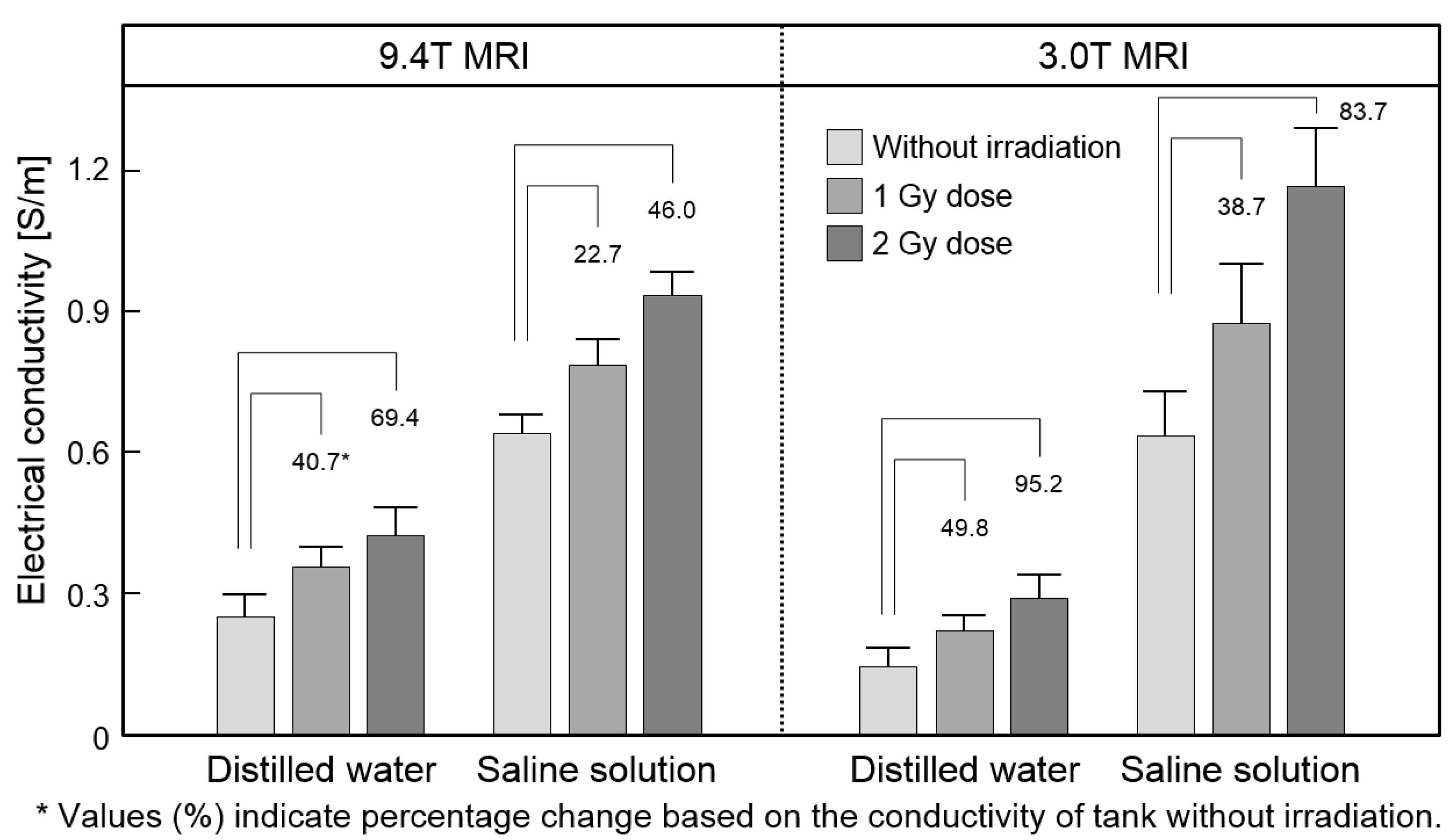
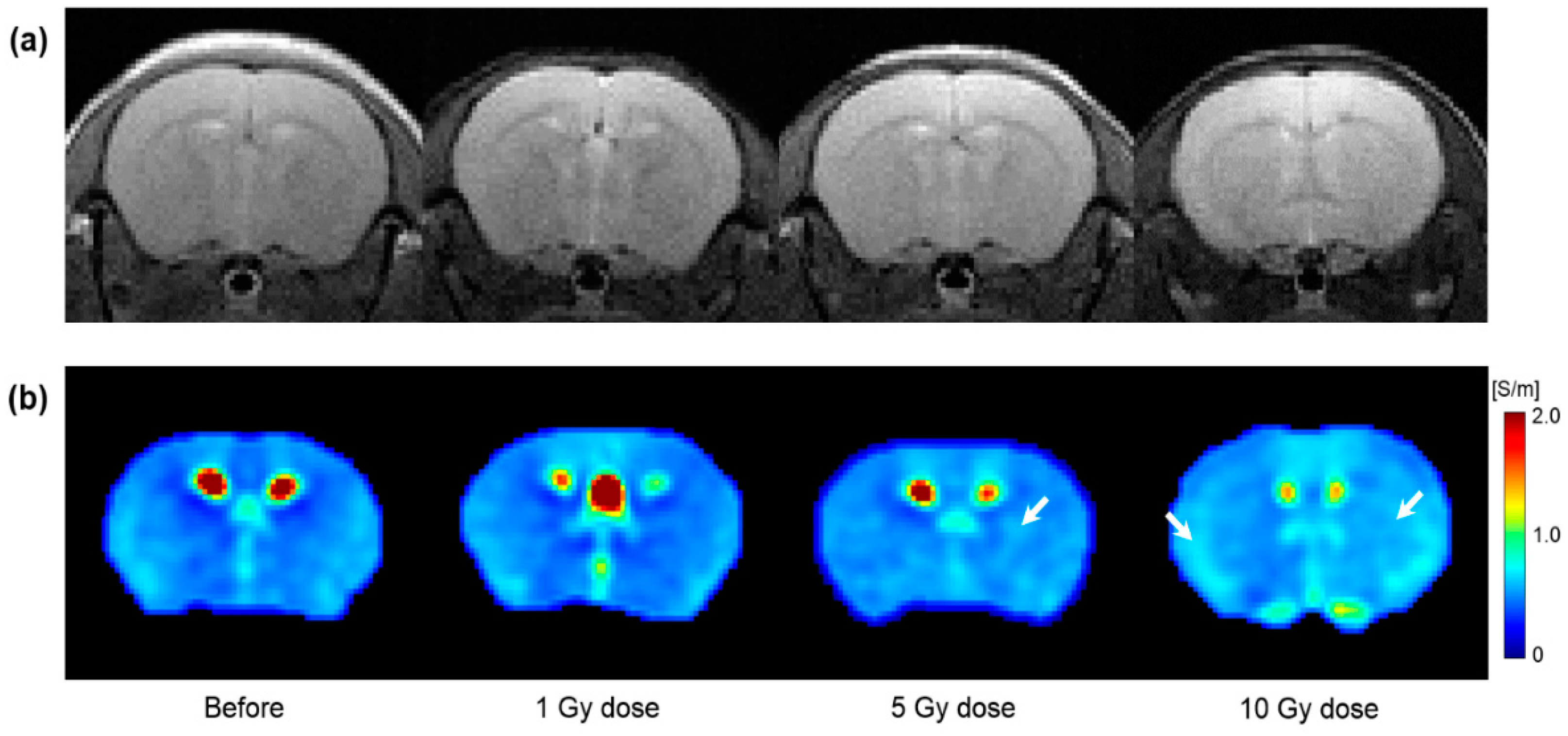


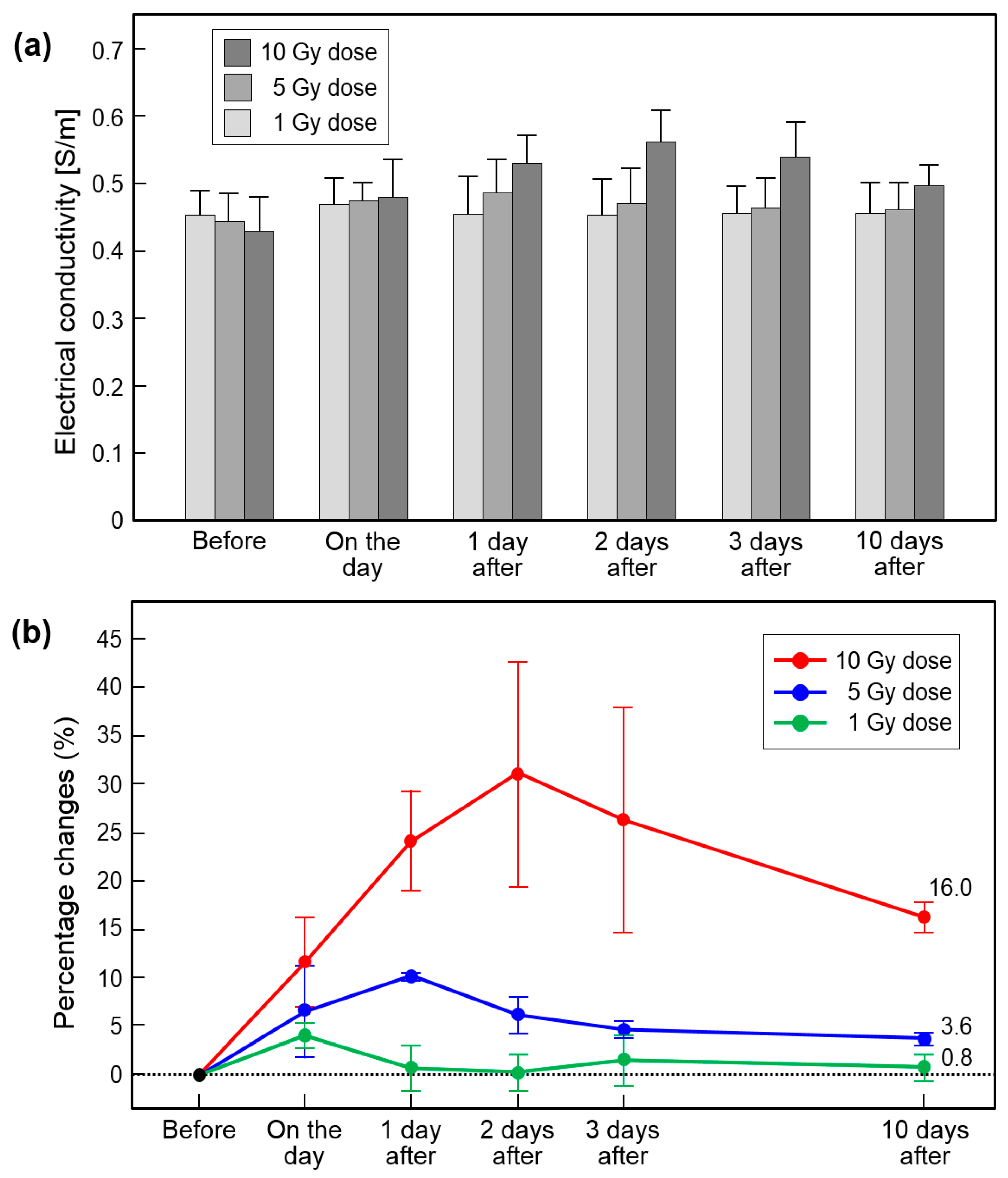
| Phantom Imaging | Electrical Conductivity (S/m) | Relative Conductivity Change (%) | |||||
|---|---|---|---|---|---|---|---|
| Without | 1 Gy | 2 Gy | Without | 1 Gy | 2 Gy | ||
| 9.4T MRI | Distilled water | 0.252 ± 0.048 | 0.355 ± 0.045 | 0.427 ± 0.055 | - | 40.7 | 69.4 |
| Saline solution | 0.643 ± 0.044 | 0.789 ± 0.052 | 0.939 ± 0.051 | - | 22.7 | 46.0 | |
| 3.0T MRI | Distilled water | 0.146 ± 0.040 | 0.218 ± 0.039 | 0.284 ± 0.061 | - | 49.8 | 95.2 |
| Saline solution | 0.637 ± 0.100 | 0.883 ± 0.131 | 1.170 ± 0.161 | - | 38.7 | 83.7 | |
| In Vivo Brain Imaging | Electrical Conductivity (S/m) (Relative Conductivity Change, %) | ||||||
|---|---|---|---|---|---|---|---|
| Before | On the Day | 1 Day after | 2 Days after | 3 Days after | 10 Days after | ||
| 1 Gy | Rat #1 | 0.436 ± 0.043 | 0.449 ± 0.032 (3.0) | 0.451 ± 0.055 (3.4) | 0.439 ± 0.046 (0.7) | 0.449 ± 0.035 (3.2) | 0.432 ± 0.042 (−0.9) |
| Rat #2 | 0.463 ± 0.032 | 0.480 ± 0.033 (3.6) | 0.456 ± 0.054 (−1.5) | 0.453 ± 0.045 (−2.1) | 0.477 ± 0.041 (3.0) | 0.469 ± 0.058 (1.2) | |
| Rat #3 | 0.455 ± 0.041 | 0.479 ± 0.060 (5.4) | 0.453 ± 0.071 (−0.4) | 0.462 ± 0.079 (1.5) | 0.447 ± 0.043 (−1.7) | 0.464 ± 0.047 (2.0) | |
| 5 Gy | Rat #1 | 0.459 ± 0.038 | 0.477 ± 0.028 (3.9) | 0.506 ± 0.053 (10.1) | 0.482 ± 0.053 (5.0) | 0.477 ± 0.039 (3.8) | 0.474 ± 0.054 (3.2) |
| Rat #2 | 0.436 ± 0.044 | 0.450 ± 0.026 (3.3) | 0.482 ± 0.041 (10.6) | 0.472 ± 0.050 (8.4) | 0.457 ± 0.045 (4.8) | 0.451 ± 0.029 (3.4) | |
| Rat #3 | 0.438 ± 0.047 | 0.490 ± 0.037 (12.0) | 0.482 ± 0.040 (10.1) | 0.459 ± 0.047 (4.9) | 0.460 ± 0.049 (5.1) | 0.457 ± 0.046 (4.3) | |
| 10 Gy | Rat #1 | 0.417 ± 0.048 | 0.454 ± 0.053 (8.8) | 0.516 ± 0.038 (23.6) | 0.545 ± 0.037 (30.7) | 0.499 ± 0.063 (19.7) | 0.476 ± 0.041 (14.1) |
| Rat #2 | 0.439 ± 0.061 | 0.480 ± 0.069 (9.2) | 0.524 ± 0.042 (19.2) | 0.527 ± 0.035 (20.0) | 0.523 ± 0.052 (19.0) | 0.513 ± 0.036 (16.8) | |
| Rat #3 | 0.425 ± 0.049 | 0.497 ± 0.061 (17.0) | 0.551 ± 0.047 (29.5) | 0.608 ± 0.073 (43.1) | 0.596 ± 0.046 (40.0) | 0.497 ± 0.026 (16.9) | |
Publisher’s Note: MDPI stays neutral with regard to jurisdictional claims in published maps and institutional affiliations. |
© 2021 by the authors. Licensee MDPI, Basel, Switzerland. This article is an open access article distributed under the terms and conditions of the Creative Commons Attribution (CC BY) license (https://creativecommons.org/licenses/by/4.0/).
Share and Cite
Kim, J.-W.; Park, J.-A.; Katoch, N.; Yang, J.-u.; Park, S.; Choi, B.-K.; Song, S.-G.; Kim, T.-H.; Kim, H.-J. Image-Based Evaluation of Irradiation Effects in Brain Tissues by Measuring Absolute Electrical Conductivity Using MRI. Cancers 2021, 13, 5490. https://doi.org/10.3390/cancers13215490
Kim J-W, Park J-A, Katoch N, Yang J-u, Park S, Choi B-K, Song S-G, Kim T-H, Kim H-J. Image-Based Evaluation of Irradiation Effects in Brain Tissues by Measuring Absolute Electrical Conductivity Using MRI. Cancers. 2021; 13(21):5490. https://doi.org/10.3390/cancers13215490
Chicago/Turabian StyleKim, Jin-Woong, Ji-Ae Park, Nitish Katoch, Ji-ung Yang, Seungwoo Park, Bup-Kyung Choi, Sang-Gook Song, Tae-Hoon Kim, and Hyung-Joong Kim. 2021. "Image-Based Evaluation of Irradiation Effects in Brain Tissues by Measuring Absolute Electrical Conductivity Using MRI" Cancers 13, no. 21: 5490. https://doi.org/10.3390/cancers13215490
APA StyleKim, J.-W., Park, J.-A., Katoch, N., Yang, J.-u., Park, S., Choi, B.-K., Song, S.-G., Kim, T.-H., & Kim, H.-J. (2021). Image-Based Evaluation of Irradiation Effects in Brain Tissues by Measuring Absolute Electrical Conductivity Using MRI. Cancers, 13(21), 5490. https://doi.org/10.3390/cancers13215490






